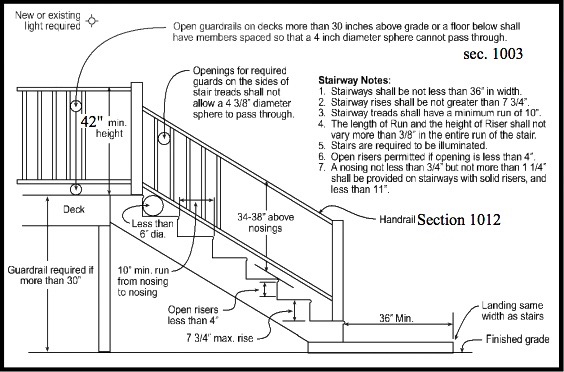




Standards and Code Considerations for Railings on Raised Decks Whether you are building a wooden deck, concrete patio, staircase, or an interior loft; your project will involve the construction of barrier railings. A barrier railing is designed to keep persons and pets safe by providing a “barrier” to prevent falls from a raised surface. Building standards and codes for railings have evolved over the years, mostly becoming more stringent for safer railings. Included in this post are some of the most common considerations for constructing a railing system on a raised deck or patio: Railing Height Code Requirements The majority of states in the U.S. require a minimum barrier railing height of 36″ from the top of the substrate (deck surface) to the top of the railing cap. Commercial projects often require a railing height of 42″ for an added factor of safety. Railings in California whether residential or commercial require a finished railing height of 42″. Stair railings require a minimum barrier height of 36″ and also the additional safety factor of a graspable railing or “grab rail” between 34″- 38″. A top railing can double as a grab railing in certain scenarios; the main consideration here is that the top railing is graspable. A graspable railing must be small enough for even a small hand to wrap the entirety of the member; often this means no larger diameter than 1.5″-2″ and not more than a 6″ perimeter measurement for the rail. Deck and Stair Height Standards for Railing Construction There are standard platform heights for when railings are required to be constructed on raised structures. The most common call out is a 30″ above grade height requirement. A common industry misperception we encounter is that a low level structure does not require a railing; or that a non code compliant railing can be constructed under a certain deck height. Code compliant deck railings are required to be constructed on any surface higher than 30″ from natural grade, including stairs. This is typically referring to natural or native grade; meaning bringing in fill to raise the grade may not satisfy the requirement. Stairs containing more than 3 risers (in some cases any stair set) are required to have railings. Additionally, when constructing railings on any raised surface (even under 30″) or retrofitting existing railings; the new railings are required to be constructed to current codes and building standards. In all cases, we recommend checking your local municipalities. Additionally, we recommend that homeowners understand that building inspectors have ultimate discretion on site if they believe something is substandard or unsafe. Standards and codes are often up to the interpretation of municipalities and their representatives or inspectors. Regulation Height for Porch Railings Construction of porch railings falls under the same regulations and standards that apply to deck railings and stairways. Although porches are often only a few steps high, they are highly trafficked and serve as raised entryways to residential homes. A porch that is at least 30″ above grade will require the same barrier railing standard as a raised deck of this height. Porch stairs should have barrier railings and also graspable railings to accommodate high traffic and often the use of young and elderly people who may pose a higher fall risk. Modern railing systems like cable railings and glass railings are an excellent choice for safety, durability, and a beautiful aesthetic. San Diego Cable Railings offers pre-made railing packages that satisfy height standards for deck railings at 36″ or 42″ requirements. Our railing posts are engineered for safety and longevity with welded connections, durable stainless steel, and heavy duty coatings. Visit the quote request page or give us a call to learn more and build a code compliant railing system for your home today. Quote Request

Understanding Railing Codes for Decks and Stairs As a general rule all decks higher than 30″ above grade are required to have a guardrail. If a property owner or contractor elects to install railings on any deck lower than 30″, the railings must still meet code. Deck railing height standards can vary from state to state but typically require a 36″ or 42″ railing. In California, deck railings are required to be a minimum of 42″ tall measured from the deck surface to the top of the guardrail. In addition, this measurement should be calculated from native grade; meaning adding loose fill to change grade elevation would not satisfy this requirement. Typical loading requirements dictate that guardrails should be strong enough to withstand 200 pounds of force applied anywhere along the top rail. A variety of infill options are allowed as long as the openings do not allow the passage of a 4″ sphere through the infill. Posts should be spaced no more than 6 feet apart for picket railings, and no more than 4 feet apart for cable style railings. Post spacing for glass panel railings is recommended at a maximum of 5 feet spacing. Any space between the deck surface and bottom rail member (sweep space) should not exceed 4″. Deck Railing Code Requirements for Stairways Guardrails are also required for stairways. The railing height for stairs is measured from the nose of the stair treads and must be installed between 34″ and 38″. Guard rails are different from graspable rails (grab rails) and one or both may be needed in order to satisfy code requirements. For example: a flat 2×4″ top rail will satisfy a guardrail requirement but is not acceptable for a graspable rail. Installers should be mindful of clear spacing rules for graspable rails which must allow 1.5″ of space between the guardrail or any wall surface. Additionally, the ends of graspable rails must be returned and/or terminated at railing posts. The bottom rail on any stair railing should not allow passage of a sphere greater than 6″ in diameter to pass through the triangular opening created by the stair riser. San Diego Cable Railings offers nationwide shipping and code compliant products designed for deck railings and stairs. Visit the quote request page or give us a call at 844-277-7327 to learn more about deck railing code requirements.